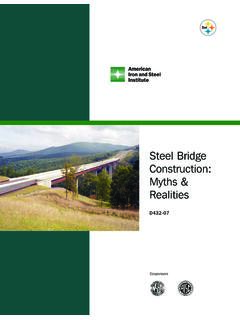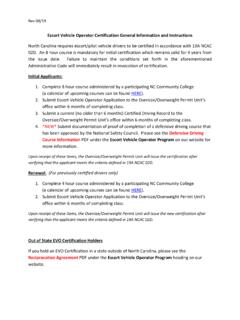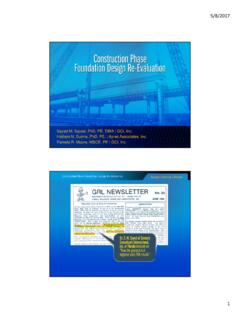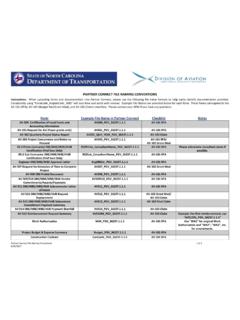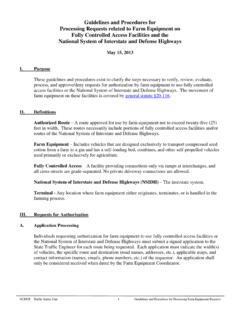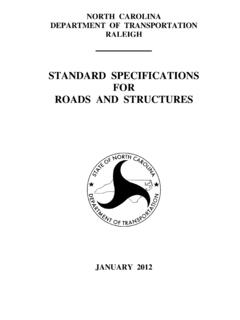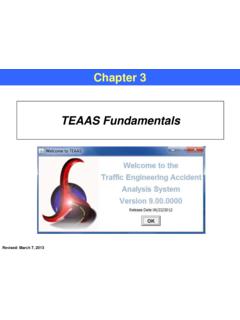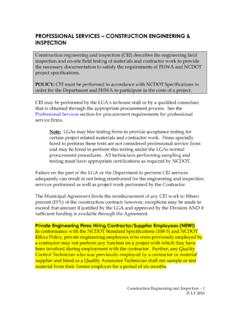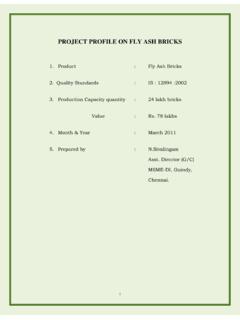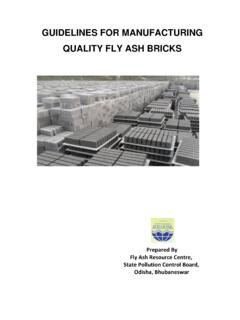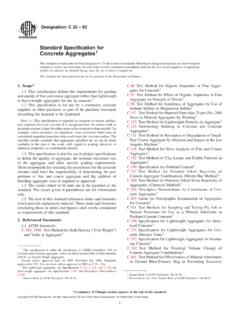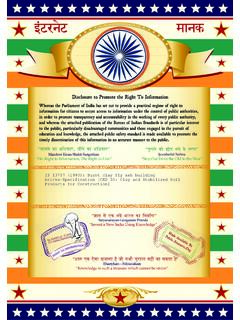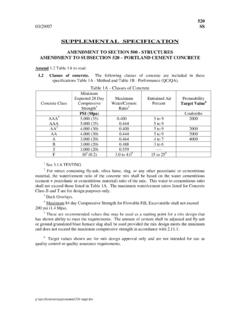Transcription of Concrete Mix Design Manual Rev08-19 - NCDOT
1 1 Concrete MIX Design TECHNICIAN STUDY GUIDE Prepared by: North Carolina Division of Highways Materials and Tests Unit Revised August 2019 2 Table of Contents Table of Contents .. 2 Section I: Basics of Mix Design .. 3 Section II: Sieve Analysis of Coarse and Fine Aggregate .. 20 Section III: Study Problems Sieve Analysis of Coarse and Fine Aggregate .. 32 Section IV: Fineness Modulus .. 38 Section V: Study Problems Fineness Modulus .. 43 Section VI: Weight Volume Relationships .. 48 Section VII: Problems Weight / Volume Relationships .. 57 Section VIII: ACI Concrete Mix Design .
2 66 Section IX: NC DOT Concrete Mix Design Specifications .. 83 Section X: Study Problems ACI Mix Design .. 92 Section XI: ACI Mix Design Variations .. 106 Section XII: Quality Concrete and Field Inspection/Control .. 120 Appendix A: Frequently Asked Questions .. 143 Appendix B: Glossary of Terms and Definitions .. 148 Appendix C: Study Questions .. 152 Appendix D: Mathematical Formulas .. 163 Appendix E: Mix Design Forms .. 164 3 Section I Basics of Mix Design 4 Introduction Concrete is a material made of cement/cementitious materials, water, and aggregates.
3 It has been used for many years in Earth s history as a building material for structures such as bridges, houses, dams, highways, sidewalks, and skyscrapers. Concrete has several properties such as strength and durability and can be cast into any shape, form and texture, and be colored for aesthetics. Unfortunately, there are some challenges still faced today in delivering uniform and high quality Concrete products, and therefore, Concrete technologies continue to be developed to modify and improve both properties of fresh and hardened Concrete . Concrete mix Design is the process of selecting suitable ingredients of Concrete and determine the relative proportions to produce Concrete with certain performance and durability requirements.
4 Different Concrete mix designs with different materials, even with the same proportions, can have significantly different properties of strength and durability. The properties of Concrete can also be affected through production, placement, finishing, and curing practices. It is therefore important that Concrete mixes are designed, produced, placed, cured, and tested by competent individuals. The learning objectives for this course include: Understand the ACI Absolute Volume Method of Concrete mix Design Know how to Design Concrete mixes using NCDOT Specifications/Special Provisions Be able to adjust mixes using 5% ACI Variations Understand Concrete mix Design submittal and approval process for NCDOT Know how to correctly complete NCDOT mix Design forms Understand the NCDOT mix Design numbering system Upon course completion and successfully passing the examination, the technician will be certified to Design and submit Concrete mixes for review and approval by the Department.
5 5 Abbreviations Specific Gravity = SG Weight = Wt. or lbs Cubic Yards = cy or yd Cubic Feet = cf or ft Pounds per Cubic Feet = pcf One hundred pounds of cement, or hundred weight = cwt Water-Cement Ratio = W/C Constants 1 gallon of water = lbs SG of water = 1 cubic yard (cy) = 27 cubic feet (cf) Unit weight of water = pcf 1 bag of cement = 94 lbs Significant Places For Rounding Pounds round to whole number Gallons round to tenth Unit Weight round to hundredth Water-Cement Ratio round to thousandths Conversion Factors 1 cubic foot = gallons 1 gallon of water = pounds 1 bag of cement = cubic foot ,(loose volume) bag of cement = cubic feet, (absolute volume) 1 cubic foot of water = lbs.
6 4 bags of cement = 1 barrel 1 cubic yard = 27 cubic feet 6 RATIO Ratio is defined as the relation between two quantities expressed as the quotient of one divided by the other. The water to cement ratio, W/C, is the weight of mix water in the Concrete divided by the weight of cement in the Concrete . The water to cementitious ratio, W/Cm, is the weight of mix water in the Concrete divided by the weight of the cementitious material, where the cementitious material is a combination of cement and pozzolans. The ratio is expressed as a decimal (example ). Ratio Rule 1: Ratio = Term 1 / Term 2 Term 1 is 300 lbs water and Term 2 is 600 lbs cement W/C = 300/600 = Note that the W/C ratio is less than one for Concrete .
7 Usually the ratio for Concrete should reflect about twice the amount of cement than water. Ratio Rule 2: Term 1 = Term 2 x Ratio Term 2 is 600 lbs cement and W/C is Term 1 = amount of water 600 x = 300 lbs of water Ratio Rule 3: Term 2 = Term 1 / Ratio Term 1 is 300 lbs of cement and W/C is Term 2 = amount of cement 300 / = 600 lbs of cement Example 1 Determine the w/c ratio of a mix, given Cement = 500 lbs, and Water = 285 lbs Answer: w/c = 285 / 500 = Example 2 Determine the water / cementitious materials ratio (w/cm) for the following: Cement = 360 Lbs fly ash = 100 Lbs GGBF Slag = 200 Lbs Water = 300 lbs Answer.
8 W/cm = 300 / (360 + 100 + 200) = 7 Example 3 Determine the mixing water weight given: w/c ratio requirement = cement factor = 620 Lbs Answer: 620 x = 248 Lbs of water Example 4 Determine w/c given a mix Design with 32 gallons of water and 517 Lbs of cement per yd. Answer: Water weight = 32 gal x = 267 Lbs w/c = 267 / 517 = Dry Rodded Unit Weight Dry rodded unit weight is sometimes called bulk or loose unit weight. Dry rodded unit weight is the ratio between the weight of the sample and the volume it occupies. ASTM C29 is used to determine the dry rodded unit weight.
9 For aggregates approved for use by NCDOT , the aggregate dry rodded unit weight is determined by the NCDOT Materials and Tests Physical Testing lab on samples submitted by M&T Materials Inspectors or their representatives. In the procedure for determining the dry rodded unit weight, only the coarse aggregate is used. Dry Rodded Unit Weight Example Weight of container plus stone = Lbs Weight of container = Lbs = Lbs = Wt of stone Volume of container = cf Dry Rodded Unit Weight = / = pcf Dry rodded unit weight has a percentage of solids and voids. The percent solids can be calculated by dividing the dry rodded unit weight by the specific gravity of the aggregate multiplied by (the weight of one cubic foot of water).
10 The result is multiplied by 100 to convert to percentage. Formula for % Solids and Voids Dry Rodded Unit Weight x 100 (Specific Gravity) x % Voids = 100 -% Solids 8 Example Dry Rodded Unit Wt = pcf of Aggregate = % Solids = x 100 = 60% x % Voids = 100 60 = 40% Portland Cement Hydration and Microstructure Hydration is the formation of a compound by the combining of water with some other substance. In Concrete , hydration is the chemical reaction between hydraulic cement and water.
